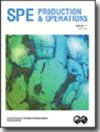通道压裂页岩气/油井长期产能预测数学模型
IF 1.3
4区 工程技术
Q2 ENGINEERING, PETROLEUM
引用次数: 1
摘要
本研究的重点是开发一个分析模型来预测通道压裂页岩气/油井的长期产能。通过将模型计算的生产率与数值结果进行比较,验证了模型的准确性。进行敏感性分析,分析影响河道压裂性能的重要参数。该模型的现场应用使用了Eagle Ford地层干气井的生产数据,该井采用通道压裂完成。给出了根据生产数据估计储层和增产参数的方法。结果表明,该模型计算的等效裂缝宽度与三次定律的反演是一致的。与数值模拟的比较表明,所提出的模型可能会低估或高估油井产能,平均绝对百分比误差(MAPE)值小于8%。敏感性分析表明,随着裂缝宽度、裂缝半长和基质渗透率的增加,通道压裂井的产能不成比例地增加。此外,在支撑剂柱稳定且裂缝宽度保持不变的情况下,随着支撑剂柱半径与通道裂缝长度之比的减小,油井产能将增加。在裂缝宽度较小、基质渗透率较大的条件下,采用通道压裂提高油井产能的效果更为显著。然而,随着裂缝宽度的增大,通道压裂的优势将会减弱。实例研究表明,该模型估算的页岩气产能与现场数据吻合较好,MAPE和R2分别为12.90%和0.93。该模型为河道压裂优化设计提供了依据。本文章由计算机程序翻译,如有差异,请以英文原文为准。
A Mathematical Model for Predicting Long-Term Productivity of Channel-Fractured Shale Gas/Oil Wells
This study focuses on the development of an analytical model to predict the long-term productivity of channel-fractured shale gas/oil wells. The accuracy was verified by comparing productivity calculated by the proposed model with numerical results. Sensitivity analysis was conducted to analyze significant parameters on the performance of channel fracturing. Field application of the model was conducted using production data obtained from an Eagle Ford Formation dry gas well, which was completed using channel fracturing. The procedure for estimating reservoir and stimulation parameters from production data was provided. The results indicated that the equivalent fracture width obtained from our model is consistent with the inversion of cubic law. Comparison with numerical simulations demonstrated that the proposed model might under- or overestimate well productivity, with mean absolute percentage error (MAPE) values of less than 8%. Sensitivity analysis indicated that, with the increase of fracture width, fracture half-length, and matrix permeability, the productivity of channel-fractured wells increases disproportionately. In addition, well productivity will increase as the ratio of the pillar radius to the length of channel fracture decreases, provided that the proppant pillars are stable and the fracture width is held constant. Under the conditions of smaller fracture width and larger matrix permeability, the effect of using channel fracturing to increase well productivity is more significant. However, as the fracture width becomes large, the benefits of channel fracturing will diminish. The case study indicated that the shale gas productivity estimated by the proposed model matches well with field data, with MAPE and R2 of 12.90% and 0.93, respectively. The proposed model provides a basis for optimizing the design of channel fracturing.
求助全文
通过发布文献求助,成功后即可免费获取论文全文。
去求助
来源期刊

Spe Production & Operations
工程技术-工程:石油
CiteScore
3.70
自引率
8.30%
发文量
54
审稿时长
3 months
期刊介绍:
SPE Production & Operations includes papers on production operations, artificial lift, downhole equipment, formation damage control, multiphase flow, workovers, stimulation, facility design and operations, water treatment, project management, construction methods and equipment, and related PFC systems and emerging technologies.
 求助内容:
求助内容: 应助结果提醒方式:
应助结果提醒方式:


